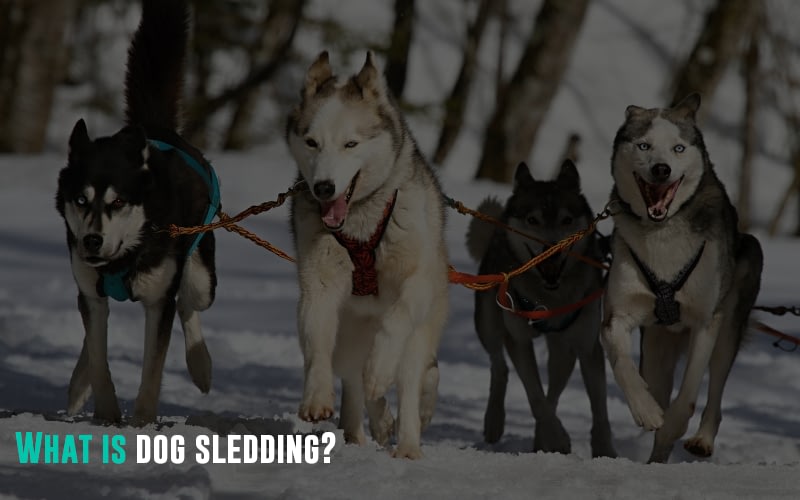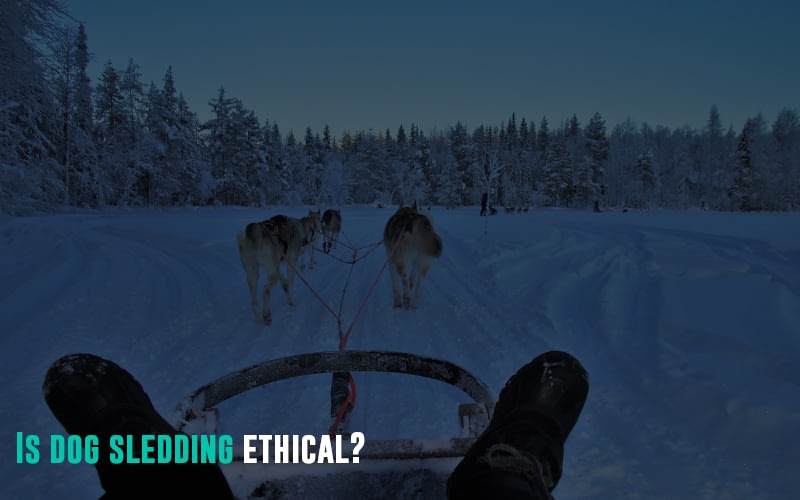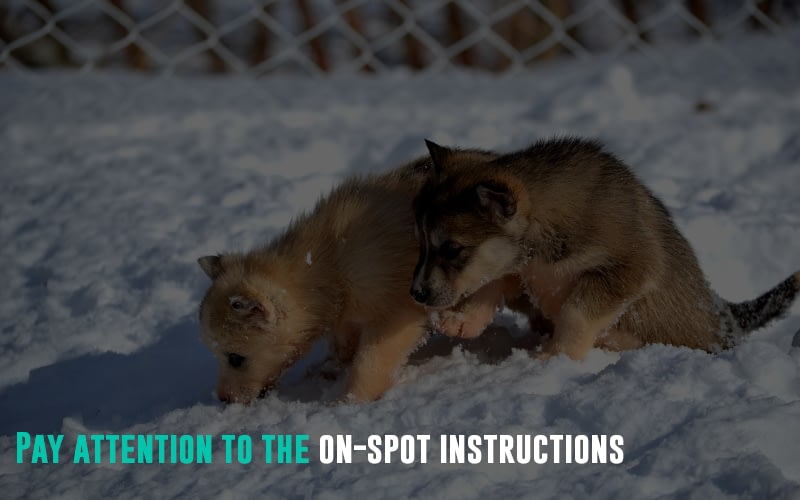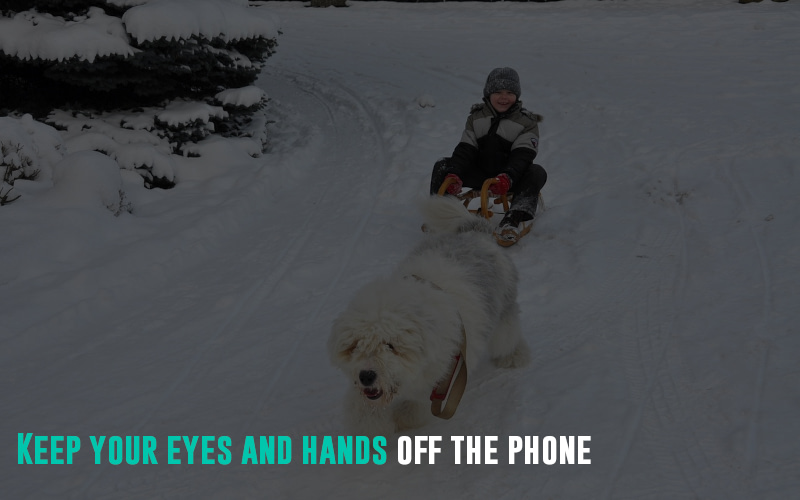If you’re like us, you might have watched the movie Togo and found yourself fascinated by the beautiful dogs and the very act of dog sledding. This heart-thumping movie is based on a dog sledding journey across hundreds of miles on dangerous, icy terrain. But luckily, there are safer ways to do dog sledding if that’s something you want to experience once in your life. This article gives you essential tips to help you prepare for a dog sledding adventure.
Featured Image Source
What is dog sledding?
Dog sledding, also called mushing, is a mode of winter transportation where a team of dogs is harnessed to pull a sled across snow and ice. It has been practiced for centuries by indigenous Arctic cultures as a way to cover long distances in harsh winter conditions.
In its essence, dog sledding involves harnessing anywhere from 4 to 16 dogs that run in front of a wooden sled called a “qamutik”. The sled is attached to the dogs via gang lines that connect their harnesses. One or two mushers (human drivers) stand on the sled’s runners and use voice commands and a braking system to control the team’s speed and direction.
The dogs do the majority of the work, combining their strength to pull the sled’s weight, including the musher, gear, supplies, and any additional passengers. Well-trained dogs work in unison, with a leader that helps direct the team and wheel dogs at the back that help steer. Various commands are used by the musher to give directions like “Gee” for right and “Haw” for left.
While dog sledding has roots in practical Arctic transportation, today it is more commonly experienced recreationally through dog sledding tours or races. Facilities will have sleds, gear, and teams of purebred sled dogs like Siberian Huskies or Alaskan Malamutes. These facilities allow both visitors and mushers to enjoy the thrill of mushing, covering shorter distances suitable for their experience level.
Is dog sledding ethical?
If you’re a dog lover, you may wonder if dog sledding—especially as a tourist attraction—is ethical. Can (and should) we use dogs like other people might use horses, mules, or bullocks?
The truth is, dog sledding itself isn’t the problem. Instead, the issue of animal cruelty starts with the handler/musher/driver and their practices when dog sledding. And while there are some instances of cruel dog mushing, this is often the exception and not the rule.
When offered by a musher who knows how to care for their dogs properly, dog sledding can be a very safe activity for both pups and adult dogs. Many mushers in the Arctic and other winter communities are born into families that have been sledding with dogs for generations. Others spend their entire lives training with experienced mushers and learning to understand canine cues. They have deep knowledge of keeping their dogs healthy and safe when sledding, ensuring they aren’t ever jeopardized. Their familiarity with the land and the local weather patterns lets them mindfully plan trips with the most negligible stressful impact on their dogs.
It’s also been found that dog sledding is a very environmentally sustainable way to travel across wintry landscapes. Since the sleds don’t use fuel, they have zero impact on the land and local wildlife.
Additionally, when it comes to dog sledding as a tourist attraction, this activity can have high earning potential during severe winters, when communities have little to no other means to make a living. In such conditions, dog sledding adventure tours can care for and house hundreds of dogs that would otherwise have to be displaced.
Key Considerations:
Ethical Treatment of Dogs One of the most important considerations for dog sledding is ensuring the ethical and humane treatment of the dogs. Choose a reputable tour operator that prioritizes the health, safety, and well-being of their canine athletes. Look for companies that follow best practices, provide ample rest for the dogs, and maintain high standards of care.
Physical Ability and Stamina
Dog sledding can be physically demanding, requiring strength, endurance, and balance. Assess your fitness level and prepare for a strenuous activity that involves standing for extended periods, maintaining control of the sled, and potentially helping the dogs if needed. Training and conditioning before your trip can help you better enjoy the experience.
Weather and Terrain
Dog sledding is heavily dependent on weather and terrain conditions. Research your destination’s climate and terrain to understand what to expect. Extreme cold, heavy snowfall, and challenging terrain can impact the difficulty and safety of the activity. Be prepared to adjust your plans if conditions are unsuitable.
Proper Gear and Clothing
Having the right gear and clothing is essential for staying warm, dry, and safe during your dog sledding adventure. Invest in high-quality winter attire, including insulated and waterproof outerwear, warm base layers, insulated boots, and accessories like gloves, hats, and goggles. Make sure you have the necessary equipment, such as a sled, harnesses, and lines, provided by your tour operator.
Keep your eyes and hands off the phone
Don’t be too focused on taking photos or videos when dog sledding. When you focus on using the phone, you might be distracted and drop the phone in the snow. Not only will this be a monetary loss, but you might end up jerking around on the sled, causing the dogs difficulty when they run. You might even distract the dogs and cause them to veer off track. Be safe and take your phone out only in designated areas when the musher accompanying you says it’s okay.
Safety and Training
Ensure that your tour operator provides proper safety briefings and training before you embark on your dog sledding adventure. Understanding how to control the sled, communicate with the dogs, and handle potential emergencies is crucial for your safety and the well-being of the animals.
Cultural Sensitivity
If you’re participating in dog sledding in an area with indigenous communities, be respectful of their cultural traditions and practices. Research the local customs, seek guidance from local experts, and approach the experience with an open mind and appreciation for the rich history and heritage behind dog sledding.
Essential Gear for Dog Sledding:
Proper Outerwear
Your outermost layer will be the most important for keeping you warm, dry, and protected from the elements. Invest in high-quality insulated and waterproof outerwear like a parka, snow pants, and boots rated for extreme cold weather. Look for items made with fabrics like Gore-Tex that block wind and moisture.
Base Layers
Layering is key for maintaining warmth. Wear thermal base layers made of moisture-wicking fabrics like polyester or merino wool against your skin. You’ll want both the top and bottom base layers.
Insulation Layers
In between your base layers and outer shell, wear one or more insulating mid-layers made of materials like fleece or down. This will help trap your body heat.
Accessories
Don’t forget essential winter accessories like a warm hat that covers your ears, insulated and waterproof gloves or mittens, goggles or sunglasses to block wind and glare, and a neck gaiter or balaclava.
Hand and Foot Warmers
These chemical heating pads are cheap but can provide welcome extra warmth when inserted into boots, gloves, or pockets on frigid days.
Hydration Pack Staying hydrated is crucial during strenuous winter activities. An insulated hydration pack with a drinking tube allows you to sip warm liquids without exposing your hands.
Safety Gear
Items like a whistle, headlamp or flashlight, multi-tool, fire starter, and first aid kit could come in handy in case of emergencies.
Safety and Training:
Before embarking on your dog sledding trip, it’s essential to receive proper safety briefings and training from your tour operator. This will help ensure your well-being as well as the welfare of the dogs.
Safety Briefing
Your tour provider should conduct a thorough safety briefing covering topics like:
- How to control the sled using brakes and voice commands
- Emergency procedures in case of accidents, injuries, or getting separated
- How to safely interact with and handle the dogs
- Environmental hazards to watch out for
- Local wildlife awareness and protocols
- Basic winter survival skills
Don’t be afraid to ask questions, and make sure you understand all the safety protocols before setting out.
Hands-On Training
In addition to the briefing, your tour should provide some hands-on training to let you practice essential skills like:
- Harnessing and harnessing the dogs properly
- Controlling the sled and using braking systems
- Communicating with the dogs using voice commands
- Basic dog handling and care
Getting some practice driving the sled on a short run first can help build your comfort and confidence.
Listening to the Guides
While on the trail, pay close attention to your guides’ instructions. They are experienced mushers with extensive knowledge of dog sledding, reading terrain, and handling animals. Following their guidance on everything, from managing the dogs to navigating challenging areas, can keep you and the team safe.
Go at Your Own Pace
Finally, don’t feel pressured to go beyond your comfort level. If you feel the conditions or terrain are too challenging, communicate that to your guides. Responsible operators will not push clients past their limits. Your safety, well-being, and enjoyment should be the priority.
Popular Dog Sledding Destinations:
Alaska, USA
- Alaska is considered the mecca of dog sledding, with a rich history and culture surrounding this winter tradition. The state offers ideal conditions with its Arctic climate, expansive snow-covered landscapes, and vast wilderness.
- Some of the most popular dog sledding destinations in Alaska include Fairbanks, Anchorage, and Juneau. These areas provide access to pristine trails winding through boreal forests, across frozen lakes and rivers, and over tundra dotted with snow-capped mountains.
- Alaska is also home to the iconic Iditarod Trail Dog Sled Race, a grueling annual long-distance competition that traverses over 1,000 miles of rugged terrain. Many tour operators here use direct descendants of the hard-working Iditarod sled dogs on their tours.
- The best time to experience dog sledding in Alaska is from December through March, when conditions are most stable and optimal. Temperatures are cold but not extreme, and there is sufficient snow coverage to allow for smooth mushing.
Lapland, Finland
- Finnish Lapland is an Arctic wonderland, providing incredible opportunities for dog sledding across the tundra. This region’s vast wilderness and perfect winter climate make it a premier destination.
- Top spots like Rovaniemi and Inari offer a range of dog sledding experiences, from short 2-3 hour tours to multi-day expeditions stopping at remote cabins along the way. The scenery is breathtaking—snow-covered forests, frozen lakes, and the haunting beauty of the northern lights.
- To take full advantage, plan your trip during Lapland’s prime dog sledding season, which runs from December through April. This ensures good snow conditions and comfortable temperatures for both people and dogs.
Quebec, Canada
- The province of Quebec, particularly the areas surrounding Quebec City, has built a reputation for world-class dog sledding experiences. Jacques-Cartier National Park, north of the city, is a prime location.
- Here you can mush through old-growth boreal forests blanketed in snow, over frozen lakes and rivers, and across open meadows, surrounded by Quebec’s classic winter beauty.
- For optimal conditions, the ideal time to visit is between January and March. During these months, there is consistent snow coverage and temperatures that are chilly but not frigid, hovering around 0 to -15 degrees Celsius.
Norwegian Lapland
- Norway’s northernmost region, Lapland, provides Arctic dog sledding terrain to rival its Finnish neighbor. Destinations like Tromsø, Alta, and Svalbard are all popular bases for tours.
- Imagine mushing across frozen fjords and valleys surrounded by jagged mountain peaks under the mystical glow of the northern lights. Nighttime tours offer opportunities for sightings of this natural phenomenon.
- The best time for dog sledding in Norwegian Lapland is between December and March, when days are short but conditions are cold and stable for ideal snow coverage.
Swiss Alps
- For a taste of dog sledding in an Alpine setting, destinations in the Swiss Alps like Grindelwald offer scenic day tours through powdery snow surrounded by towering mountain peaks.
- Sledding here provides a different experience than in Arctic environments. You’ll mush through conifer forests and alpine meadows, with stunning vistas of the mighty Swiss Alps all around. The scenery is dramatic and picturesque.
- The peak dog sledding season in the Swiss Alps runs from January through March. Temperatures are typically below freezing but not extremely cold, and there is ample snowfall to create ideal mushing conditions.
Greenland
- The vast, remote wilderness of Greenland provides a perfect setting for expedition-style dog sledding trips spanning multiple days.
- These adventures allow you to traverse frozen fjords, rugged glacial terrain, and Arctic tundra far off the beaten path. You’ll travel in the traditional style, with tent camping along the route.
- Expeditions are typically run in the spring, from March to May. During this time, the weather is still reliably cold with good snow coverage, but the days are getting longer, allowing for scenic mushing under springtime Arctic light.
Yellowstone National Park, USA
- America’s iconic Yellowstone National Park in Wyoming offers unique opportunities for dog sledding day tours in a stunning natural setting.
- Imagine gliding past steaming geysers, snow-draped lodgepole pine forests, and sweeping valley vistas backdropped by mountains. You’ll be mushing under the watchful eyes of Yellowstone’s expert guides.
- The dog sledding season in Yellowstone runs from mid-December to early March. This window provides reliable snow and cold temperatures to fully enjoy this scenic winter activity.
The Best Time for Dog Sledding:
- Generally, the heart of the winter season, from late December through March, is considered the best overall time for dog sledding adventures.
- This period offers the most stable conditions across many top destinations, with sufficient snow coverage and temperatures that are cold but not extreme.
- However, prime timing can vary a bit depending on the location. Arctic and alpine environments have slightly different seasonal peaks.
- So while late winter is typically ideal, always research the specific destination to determine the optimal time window for trail conditions and tour availability. When it comes to dog sledding, timing is key to maximizing your experience.
Conclusion:
Dog sledding lets you ride through the snow on a sled pulled by a team of dogs. Driving the sled and yelling commands to the dogs is really exciting! But you need to plan carefully for this special adventure. Learning to steer the sled and work with the dogs takes practice.
Travel-wise, we know planning a trip is exciting, but it can also feel confusing with so many things to organize. A good trip planning tool makes it much easier. The Travel-Wise Trip Planner app lets you easily build trip itineraries, manage your budget, and share trip details. It has helpful features that save you time when planning your next adventure. If you want to be wise in your travels, learn more about how the Trip Planner works. Or just start using it now to plan your next fun trip! The Travel-Wise tools help you make your dream trip happen. When will you go to your next dog-sledding adventure?





